"The Herb Garden"
July 23, 2009
- Vol 1, Issue 11
| |
|
E-News Drawing
|
If you
receive our newsletter, you will be entered into a
drawing each month for a great prize for your
kitchen. Check here each month to see if you have
won, if so, come in to collect your prize!
June's
winner:
Eber Fuller
Eber won a Garlic Knife.
Congrats Eber, come by anytime to pick up your
prize. | |
|
| July Wine of the
Month |
|
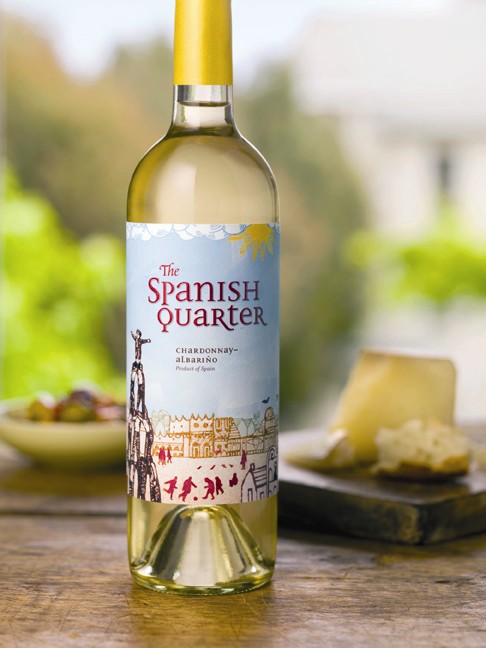
A Spanish
Quarter 2007 White Wine
A Chardonnay/Albarino
Blend from Spain
$12.00

Paul Cheneau Cava Sparkling
Wine
Sparkling Wine from
Spain
$13.00
|
| New Monthly Contest...
"Stumped Us" |
It
seems like a few times a month a customer comes into
Cucina Fresca with a question, product, or quandary that
simply stumps us. The answer is usually found with a
quick google search, but we thought this could turn into
a fun contest. Each month we will feature one of the
things that "Stumped Us", if you email us the correct
answer you will be entered to win a monthly prize.
a
We're
thrilled with the number of responses so far in July. If
you didn't answer last time, you still have
time!
July's
"Stumped Us" Question:
"What are "Grains of
Paradise?"
|
Elko Downtown Upcoming
Events!
|
Elko
Downtown Business Association Upcoming
Events:
3rd
Thursdays Girls' Night Out Shopping Event
Thursday,
August 20th
Participating
Stores Open until 7pm
Game-themed
Shopping Savings at Downtown
Stores
3rd
Annual Elko DBA Wine Walk Dates
Saturday,
August 8th
Saturday, September 12th
|
Cucina Fresca's Upcoming
Events!
|
|
|
Father's Day Basket
Winner
|
Congratulations to Shawn
Sabala -- the winner of the Father's
Day Basket Drawing! The basket was
sponsored by Cucina Fresca and the Elko County
Cattlewomen. Shawn's son, Heston,
entered him in the contest. We hope they enjoy the
great selection of items in the basket!
| | |
|
Essential Kitchen
Herbs
|
Even
without a green thumb, these herbs are accessible to any
kitchen gardener or farmers' market fan. With these nine
herbs, the summer harvest of other fresh, local produce is
enhanced and showcased to the palate's
perfection.
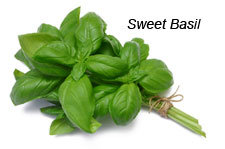 Basil
- Perhaps the most utilized summer herb, basil adds its sweet
and strong essence to many summer favorites. The herb is said
to have hints of clove and anise. Keep pinching the tips of
this tender annual plant to encourage branching and discourage
flowering. After flowering, the basil flavor becomes bitter.
The most commonly found basil with its large, floppy leaves is
known as lettuce basil. Experiment with the many varieties
available: purple basil, long-lasting Thai basil, lemon basil,
lime basil, and many others. Basil
- Perhaps the most utilized summer herb, basil adds its sweet
and strong essence to many summer favorites. The herb is said
to have hints of clove and anise. Keep pinching the tips of
this tender annual plant to encourage branching and discourage
flowering. After flowering, the basil flavor becomes bitter.
The most commonly found basil with its large, floppy leaves is
known as lettuce basil. Experiment with the many varieties
available: purple basil, long-lasting Thai basil, lemon basil,
lime basil, and many others.
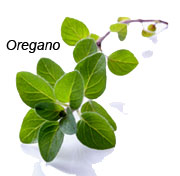 Oregano
- Essential in Greek and Italian cuisines, oregano is a hardy
perennial with small, fragrant leaves. Strong in flavor with a
peppery quality, oregano pairs well with basil, lemon, lamb,
pork and nearly all kinds of vegetables. Throw a few sprigs of
oregano, including their woody stems, on your grill's
charcoals for extra infused flavor. Oregano
- Essential in Greek and Italian cuisines, oregano is a hardy
perennial with small, fragrant leaves. Strong in flavor with a
peppery quality, oregano pairs well with basil, lemon, lamb,
pork and nearly all kinds of vegetables. Throw a few sprigs of
oregano, including their woody stems, on your grill's
charcoals for extra infused flavor.
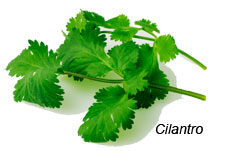 Cilantro
- A frequent ingredient in Mexican and Asian foods, fresh
cilantro is sometimes called Chinese parsley. The seeds of the
cilantro plant become the spice, coriander. Cilantro, pungent
and spicy, is usually added to preparations just at the end of
cooking. Cilantro does not retain its flavor when dried, so
fresh is always best. It does hold its flavor well when
chopped and frozen in water or olive oil. Cilantro
- A frequent ingredient in Mexican and Asian foods, fresh
cilantro is sometimes called Chinese parsley. The seeds of the
cilantro plant become the spice, coriander. Cilantro, pungent
and spicy, is usually added to preparations just at the end of
cooking. Cilantro does not retain its flavor when dried, so
fresh is always best. It does hold its flavor well when
chopped and frozen in water or olive oil.
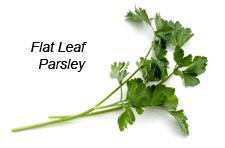 Parsley
- Readily recognizable and currently maligned as an overused
garnish, parsley deserves a second look as a fresh, mild herb.
Flat parsley, also known as French or Italian parsley, has the
preferred flavor for cooking compared with curly parsley whose
ruffles make for a good garnish. Parsley pairs well with fish,
lemon, eggs, and most vegetables. Parsley
- Readily recognizable and currently maligned as an overused
garnish, parsley deserves a second look as a fresh, mild herb.
Flat parsley, also known as French or Italian parsley, has the
preferred flavor for cooking compared with curly parsley whose
ruffles make for a good garnish. Parsley pairs well with fish,
lemon, eggs, and most vegetables.
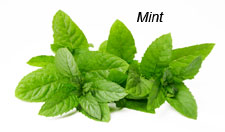 Mint
- Mint packs a punch as a culinary herb. Our palates are
somehow cooled by the mint, almost with a slight numbing
sensation in the mouth. Culinary uses of mint are prevalent in
Middle Eastern dishes and Indian foods. Mint
- Mint packs a punch as a culinary herb. Our palates are
somehow cooled by the mint, almost with a slight numbing
sensation in the mouth. Culinary uses of mint are prevalent in
Middle Eastern dishes and Indian foods. 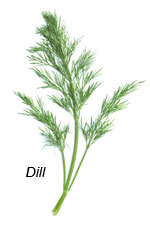 Mint
is one of just a few herbs that match well with fruit and
chocolate. It's easy to grow your own mint, though due to its
aggressiveness it should always be contained in a
pot. Mint
is one of just a few herbs that match well with fruit and
chocolate. It's easy to grow your own mint, though due to its
aggressiveness it should always be contained in a
pot.
Dill - The
feathery fronds of dill (a.k.a. dill weed) pair perfectly with
fish and seafood. Dill gained its reputation as an
indispensable herb from northern and central European cuisines
whose root vegetables seem to have an affinity for dill. Dill
weed freezes well and holds its flavor better than dried dill.
Try dill in potato salad and salad dressings.
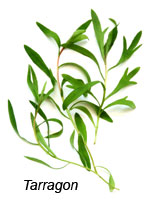 Tarragon
- The flavor of tarragon is strong, yet subtle. It has an
anise or licorice character that is famous in French cooking.
The long slender leaves add a classic flavor to vinegars,
mustards, and butters. Tarragon chicken and the classic
Bearnaise sauce are two favorite dishes that would be nothing
without tarragon. The tarragon flavor holds up well in
slow-cooking applications. Tarragon
- The flavor of tarragon is strong, yet subtle. It has an
anise or licorice character that is famous in French cooking.
The long slender leaves add a classic flavor to vinegars,
mustards, and butters. Tarragon chicken and the classic
Bearnaise sauce are two favorite dishes that would be nothing
without tarragon. The tarragon flavor holds up well in
slow-cooking applications.
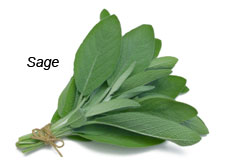 Sage
- Another hardy perennial, sage has Mediterranean origins with
beautiful soft gray-green coloring. Pungent and spicy, fresh
sage should be used readily once picked. Dried sage is quite a
bit more potent than fresh sage. Sage pairs well with apples,
beans, onions and tomatoes. Explore the multiple types of sage
available including tricolor sage, golden sage, clary sage and
pineapple sage. Sage
- Another hardy perennial, sage has Mediterranean origins with
beautiful soft gray-green coloring. Pungent and spicy, fresh
sage should be used readily once picked. Dried sage is quite a
bit more potent than fresh sage. Sage pairs well with apples,
beans, onions and tomatoes. Explore the multiple types of sage
available including tricolor sage, golden sage, clary sage and
pineapple sage.
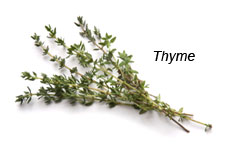 Thyme
- These tiny leaves pack a punch! Another Mediterranean herb,
thyme grows as a low-growing shrub. The leaves need to be
stripped from the woody stems prior to use. Thyme holds up
well in long-cooking applications and "plays well" with other
herbs. Our favorite is lemon thyme for both its taste and its
appearance. Thyme
- These tiny leaves pack a punch! Another Mediterranean herb,
thyme grows as a low-growing shrub. The leaves need to be
stripped from the woody stems prior to use. Thyme holds up
well in long-cooking applications and "plays well" with other
herbs. Our favorite is lemon thyme for both its taste and its
appearance.
It's hard to end the list just with these
herbs - there are so many more that add delight to the garden
and the kitchen . . . rosemary, chives, marjoram. . .
.
|
Cooking with
Herbs
|
Preparing
and using fresh herbs with confidence will release their magic
into your kitchen. Each herb grows differently and that
impacts their handling in the kitchen. Here are a few
essential techniques for using fresh herbs:
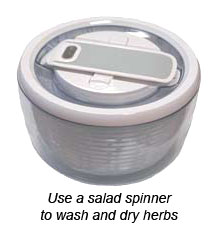 Washing
Herbs - Rinse fresh herbs with water taking
care to expose the undersides of the leaves to the running
water. Alternatively, swish the herbs in a bowlful of cold
water. Shake excess water away and allow them to air dry for a
few minutes before chopping. For larger quantities of leafy
herbs, use a salad spinner for washing and
drying. Washing
Herbs - Rinse fresh herbs with water taking
care to expose the undersides of the leaves to the running
water. Alternatively, swish the herbs in a bowlful of cold
water. Shake excess water away and allow them to air dry for a
few minutes before chopping. For larger quantities of leafy
herbs, use a salad spinner for washing and
drying.
Stripping the
Leaves - For many herbs it's just the leaves that are
used in cooking. The stems may be too woody or stringy to be
palatable. The leaves of some herbs, (i.e., thyme, tarragon,
oregano), may be stripped easily from their stem by pulling
the stem through two pinched fingers. The leaves are stripped
away into a neat pile; discard the stems.
Knife Chopping - Many herbs
are used in chopped form. Use a chef's knife in a rocking
m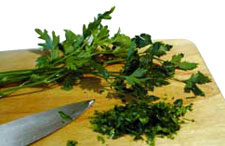 otion
to mince fresh herb leaves. Chop the herbs just as you're
ready to use them. The chopping process bruises the leaves and
releases many of the herb's essential oils and aromas. Capture
these essences by chopping and using immediately. otion
to mince fresh herb leaves. Chop the herbs just as you're
ready to use them. The chopping process bruises the leaves and
releases many of the herb's essential oils and aromas. Capture
these essences by chopping and using immediately.
Cutting with Herb Scissors -
Slightly odd looking, but amazingly effective, herb scissors
have multiple blades that cut simultaneously. Perfect ribbons
and even pieces are accomplished with each cut.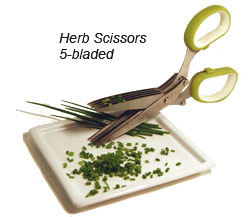
Food Processor Chopping - For
larger quantities of herbs, a food processor is invaluable for
achieving uniform results. Pulse 2-3 times, scrape down the
sides and repeat until the desired size of chopped herb is
reached.
Mini-Processor
Chopping - Small quantities of herbs, including garlic,
are an ideal use for a mini-processor. Use the same pulse and
scrape technique as with a larger food processor.
Chiffonade - This classic
cutting technique is an essential one to master with
broad-leaved herbs such as basil. Layer leaves on top of each
other, then roll the layers into a tight log with all leaf
stems at one end. Thinly slice across the log of leaves
discarding the stem ends. 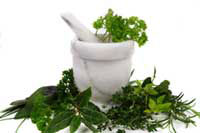 The
result is ribbons, or thin strips of fragrant herbs. Sprinkle
the chiffonade on top of your dish as in the traditional
Caprese Salad. The
result is ribbons, or thin strips of fragrant herbs. Sprinkle
the chiffonade on top of your dish as in the traditional
Caprese Salad.
Pounding - The traditional
method for many herbal preparations is with a mortar &
pestle. The mortar is the bowl portion and the pestle is the
pounding and grinding stick. Food is pulverized by pushing and
scraping the pestle against the sides of the mortar. Mortars
and pestles may be made of wood, porcelain, and
conventionally,
stone.
|
Preserving Garden
Herbs
|
"Make hay
while the sun shines." Capture fresh herbs while they're
available in abundance. Like so much in the garden, the plenty
comes all at once!
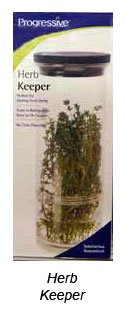 Storing
Fresh Herbs - Refrigerate unwashed fresh herbs
that you intend to use soon. (If the herbs are wet, shake any
excess water away and allow to air dry prior to
refrigerating). Place the herbs in the warmest spot of your
refrigerator. Many herbs, for example, basil and mint, are
very tender and susceptible to the 38 - 40°F temperatures of
an icebox; if too cold, the leaves will turn black. An herb
keeper is a handy device that provides fresh water to the
stems and leaves while keeping the herbs cool in the
refrigerator. Storing
Fresh Herbs - Refrigerate unwashed fresh herbs
that you intend to use soon. (If the herbs are wet, shake any
excess water away and allow to air dry prior to
refrigerating). Place the herbs in the warmest spot of your
refrigerator. Many herbs, for example, basil and mint, are
very tender and susceptible to the 38 - 40°F temperatures of
an icebox; if too cold, the leaves will turn black. An herb
keeper is a handy device that provides fresh water to the
stems and leaves while keeping the herbs cool in the
refrigerator.
Drying - Fresh herbs, after
washing as noted above, may be dried in several different
ways:
- Air
drying - Bunch the herbs together making a "bouquet."
Tie the stems together with kitchen twine and hang upside
down in a dark, well-ventilated place.
- Oven
drying - Arrange the herb leaves in a single layer on
a baking sheet. Place in a warm oven on the lowest setting
possible. Leave undisturbed in the oven until the leaves are
thoroughly dried.
- Microwave
drying - Spread the herbs between two paper towels
and microwave in 30 second bursts. Remove the leaves as they
become dry. Allow to cool. Brighter greens seemed to
be retained with this method of drying.
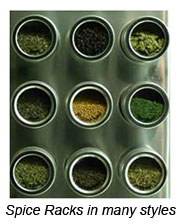 Storing
Dried Herbs - Once dried, store the herbs in a
dark location in an airtight container. Store the container in
a cool location - not near the heat of a stove. Plan to use
most dried herbs within six months. Storing
Dried Herbs - Once dried, store the herbs in a
dark location in an airtight container. Store the container in
a cool location - not near the heat of a stove. Plan to use
most dried herbs within six months.
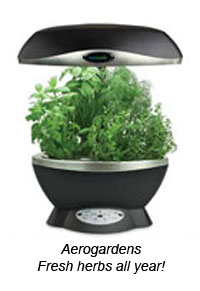 Freezing - Wash and chop the
herbs. Package in thin layers for quick freezing.
Alternatively, add a small amount of water to the chopped
herbs and freeze the slurry in ice cube trays. Once frozen,
store the cubes in a freezer-grade zipper bag and use as
needed. Olive oil may also be used to create an herbal
suspension for freezing. Freezing - Wash and chop the
herbs. Package in thin layers for quick freezing.
Alternatively, add a small amount of water to the chopped
herbs and freeze the slurry in ice cube trays. Once frozen,
store the cubes in a freezer-grade zipper bag and use as
needed. Olive oil may also be used to create an herbal
suspension for freezing.
Off Season Herbs with
Aerogarden - To enjoy fresh summer herbs all year-long,
start an indoor Aerogarden. Specially created for the kitchen,
Aerogardens provide fresh herbs, petite tomatoes and other
crops on a consistent basis during the off seasons. New
Aerogarden models are available that are smaller in size than
the original Aerogarden, including a model that fits handily
in a corner.
|
Cucina Fresca's Herb
Tips
|
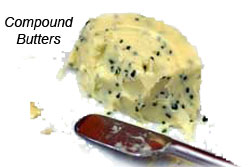 Tip
#1: Enjoy some compound butters with your
harvest of herbs. Soften a stick of butter; mix 2-3
tablespoons of finely chopped, fresh herbs into the butter
until evenly distributed. Roll the butter into round logs,
wrap tightly and freeze. Cut slices of the butter as needed.
Use on bread, vegetables, or as a simple pasta
sauce. Tip
#1: Enjoy some compound butters with your
harvest of herbs. Soften a stick of butter; mix 2-3
tablespoons of finely chopped, fresh herbs into the butter
until evenly distributed. Roll the butter into round logs,
wrap tightly and freeze. Cut slices of the butter as needed.
Use on bread, vegetables, or as a simple pasta
sauce.
Tip
#2: Add a stunning savory garnish with some fried
sage. Heat 2 tablespoons of butter in a small skillet. Toss in
a dozen or so individual sage leaves and allow them to sauté
until crisp. The brown butter and sage flavor meld into
perfect herbal "glitter."
Tip #3: A classic tip,
scoop up bunches of basil at farmers' market and "put by" the
basil bounty for the cooler days ahead. Strip the leaves from
the stems, wash, spin, or pat dry. Chop the leaves with the
help of some olive oil in your food processor. 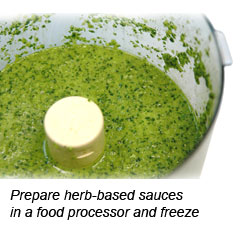 Freeze
small quantities of the paste in ice cube trays. Once frozen,
package the cubes in freezer-grade zipper bags. Access the
cubes for inclusion in a soup or sauce, or for finishing into
a pesto. Freeze
small quantities of the paste in ice cube trays. Once frozen,
package the cubes in freezer-grade zipper bags. Access the
cubes for inclusion in a soup or sauce, or for finishing into
a pesto.
Tip
#4: Dried herbs are generally added at the
beginning of recipes so that they can rehydrate and release
their flavors. Fresh herbs are generally added just at the end
of cooking. A little heat will often help to bloom the herb's
flavor, fresh or dried.
Tip #5: When cooking
with herbs, add a little wine or vermouth to the mix. Alcohol
dissolves certain essential oils releasing flavors in a way
that water and oil are not able to
accomplish.
|
Q &
A's
|
 Q: What's the difference
between "herbs" and "spices"? Q: What's the difference
between "herbs" and "spices"?
A: An innocent
question with a lot of different answers depending who you
ask! The consensus seems to be that an "herb" refers to the
fresh form of the plant's leaves, while "spice" refers to
dried forms of aromatic plants and can include seeds, bark,
stems, and other plant parts. This definition begs the
question whether dried herbs are then spices, but we'll let
you choose that answer!
Q: What is the ratio for
substituting dried herbs for fresh herbs and fresh for
dried?
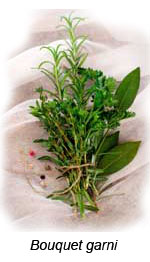 A:
Dried herbs carry more concentrated flavor than fresh herbs.
If the recipe calls for fresh herbs, use one-third the
quantity of dried herbs. Conversely, if the recipe calls for
dried herbs, use three times the quantity of fresh
herbs. A:
Dried herbs carry more concentrated flavor than fresh herbs.
If the recipe calls for fresh herbs, use one-third the
quantity of dried herbs. Conversely, if the recipe calls for
dried herbs, use three times the quantity of fresh
herbs.
Q: What
does the term "bouquet garni" mean?
A: In French cooking,
bouquet garni, refers to a bundle of herbs tied with string or
wrapped in cheesecloth and added to slow-cooking dishes. The
bouquet garni is removed from the pot prior to serving. The
classic French version consists of bay leaf, parsley, and
thyme. Other combinations of herbs can be assembled according
to the dish being prepared.
Q: What is the correct
pronunciation of herb?
A: Some say
"erb," others pronounce the "h" in the word "herb." It seems
to be an American quirk to drop the "h." Some say it's a
throwback to early, French pronunciations of the word. Most
other English-speaking countries pronounce the "h." Both
pronunciations are so well entrenched in culture that they're
both considered correct - it's a matter of dialect and local
custom which one you choose to say.
Q: How long do dried herbs
remain fresh?
A: Freshness is
dependent on the storage conditions, but experts recommend
keeping dried herbs no longer than six months. Buy small
quantities of excellent quality herbs for best recipe results.
To check freshness, crumble a few leaves between your fingers
and assess the aroma's
strength.
|
Cookbook
Review
|
Herbs
& Spices, a Cook's Reference by Jill Norman.
Photography by Dave King. Copyright 2002. Published by DK
Publishing, Inc., New York, NY.
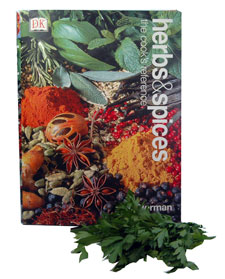 True
to its title, this book is primarily a reference on scores of
herbs and spices from a cook's point of view. The book is
divided into three parts: Herbs, Spices and Recipes. Each herb
and spice is lavishly illustrated with stunning photography.
The photos depict the herb or spice in its various forms so
that each entry becomes a definitive field guide for the cook.
While official botanical names are noted, the bent of
information is all culinary. The taste is described, culinary
uses identified, buying and storing instructions noted, and
tips on growing your own presented. We thought we knew herbs
and spices fairly well, but each entry offered us new
information. The featured herbs and spices are global; we
found this the most helpful aspect for its ability to broaden
our knowledge base for ethnic cooking explorations. This
global reach is echoed in the Recipe section where spice
mixtures are organized by country of origin. The book
concludes with loaded chapters on Sauces and Condiments,
Marinades, Soups and Light Dishes, Fish, Meats, Vegetables,
Pasta and Grains, and Desserts and Drinks. A helpful
bibliography and excellent index end the book. It's a
beautiful book to the eye and a prime resource for the kitchen
cook. True
to its title, this book is primarily a reference on scores of
herbs and spices from a cook's point of view. The book is
divided into three parts: Herbs, Spices and Recipes. Each herb
and spice is lavishly illustrated with stunning photography.
The photos depict the herb or spice in its various forms so
that each entry becomes a definitive field guide for the cook.
While official botanical names are noted, the bent of
information is all culinary. The taste is described, culinary
uses identified, buying and storing instructions noted, and
tips on growing your own presented. We thought we knew herbs
and spices fairly well, but each entry offered us new
information. The featured herbs and spices are global; we
found this the most helpful aspect for its ability to broaden
our knowledge base for ethnic cooking explorations. This
global reach is echoed in the Recipe section where spice
mixtures are organized by country of origin. The book
concludes with loaded chapters on Sauces and Condiments,
Marinades, Soups and Light Dishes, Fish, Meats, Vegetables,
Pasta and Grains, and Desserts and Drinks. A helpful
bibliography and excellent index end the book. It's a
beautiful book to the eye and a prime resource for the kitchen
cook.
|
Recipes featuring Summer
Herbs
|
Recipes excerpted from Herbs
& Spices, a Cook's Reference by Jill Norman.
Photography by Dave King. Copyright 2002. Used with permission
of the publisher, DK Publishing, Inc., New York, NY. All
rights reserved.
Salsa
Verde
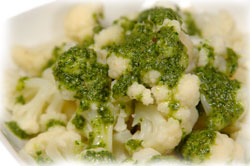 This
rather generic name applies to dozens of green sauces. This
version deploys parsley, a choice of mint or basil, and some
punch from garlic and capers. The result of 5 minutes of
effort was a tasty sauce for our cauliflower. If you're
looking for ways to jazz up any vegetable, meat or pasta, this
version of salsa verde will yield excellent
results. This
rather generic name applies to dozens of green sauces. This
version deploys parsley, a choice of mint or basil, and some
punch from garlic and capers. The result of 5 minutes of
effort was a tasty sauce for our cauliflower. If you're
looking for ways to jazz up any vegetable, meat or pasta, this
version of salsa verde will yield excellent
results.
Click here to view the illustrated
recipe.
Click here for a
printable
version of the recipe.
Pesto
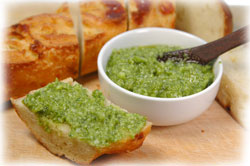 The
summer classic, pesto, has been popular for a long time, some
would say past popularity. We think it still deserves
attention during fresh basil season. If you're looking for
some variation, this recipe has three - Cilantro-Walnut (our
new favorite pesto!), Parsley-Almond, and Arugula-Pine Nut.
Equally at home as a bruschetta topping, a pasta dish, or a
vegetable sauce, pesto still rules! The
summer classic, pesto, has been popular for a long time, some
would say past popularity. We think it still deserves
attention during fresh basil season. If you're looking for
some variation, this recipe has three - Cilantro-Walnut (our
new favorite pesto!), Parsley-Almond, and Arugula-Pine Nut.
Equally at home as a bruschetta topping, a pasta dish, or a
vegetable sauce, pesto still rules!
Click here to view the illustrated
recipe.
Click here for a
printable
version of the recipe.
Green
Mojo
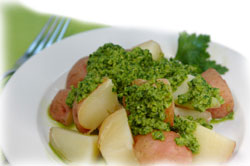 Inspired
by a potato dish from the Canary Islands, this herb-based
sauce gets its mojo from three hot peppers. It gets its
freshness from parsley, and added complexity from a little
cumin. The sauce base is a combination of wine vinegar and
olive oil. Also ready in 5 minutes, this sauce is delicious on
fish, meat, and even as a salad dressing. Inspired
by a potato dish from the Canary Islands, this herb-based
sauce gets its mojo from three hot peppers. It gets its
freshness from parsley, and added complexity from a little
cumin. The sauce base is a combination of wine vinegar and
olive oil. Also ready in 5 minutes, this sauce is delicious on
fish, meat, and even as a salad dressing.
Click here to view the illustrated
recipe.
Click here for a
printable
version of the
recipe.
|
Bridal
Registry
|
Wedding
dates have been set! Join us in celebrating the engagements
and pending nuptials for the following couples registered at
Cucina Fresca in 2009:
Jody
Gill and Dustin Allen
Wedding Date:
June 6, 2009
Mandi
Phillips and Boyd Ratliff
Wedding Date:
June 15,
2009
Andrea
Mori and Chad Sestanovich
Wedding
Date: June 20,
2009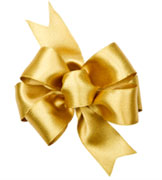
Ruth Meyer and Tim
Feldman
Wedding Date: June 27,
2009
Victoria Nalywaiko and
Nicholas Richardson
Shower Date: June 5,
2009
Wedding Date: July 4,
2009
Korrie Vance
and Shaun Hornbarger
Wedding Date: July 18,
2009
(Wedding
Registry List is available online)
Carrie
Kelley and Joe Lostra
Wedding Date: July 18,
2009
Tracy
Tinnin and William Ouellet
Wedding Date: July 25,
2009
Renee Butler
and Jered Betancourt
Shower
Date: July 18, 2009
Wedding Date: August 1,
2009
(Wedding
Registry List is available
online)
Holly
Gilbertson and Brett Hoffman-
Wedding Date:
August 15, 2009
(Wedding
Registry List is available online)
| |
Enjoy the
freshness of summer's herbs!
|
|
| |